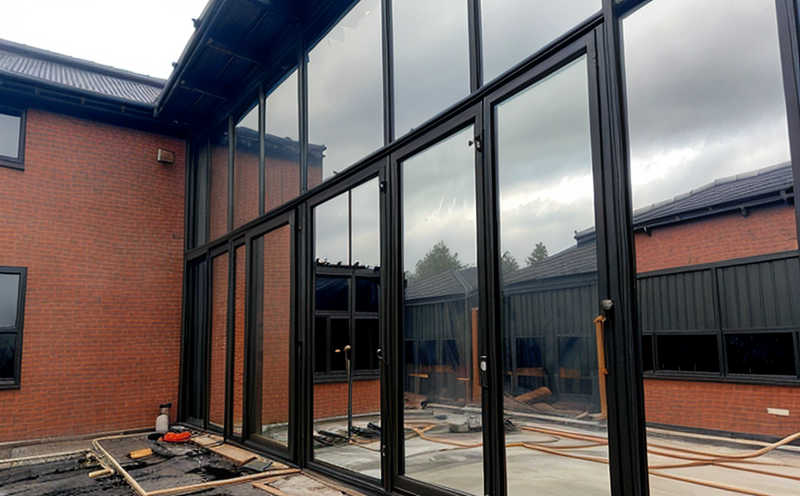Fire resistant glazing inspection
The importance of fire safety cannot be overstated in modern architecture and construction. Fire-resistant glazing is a critical component designed to withstand the intense heat and pressure generated by a fire, thereby providing additional protection for building occupants and firefighters. This service focuses on inspecting such glazing to ensure compliance with relevant standards and regulations.
The inspection process involves several steps, including visual examination, dimensional checks, and mechanical testing. Visual examinations are conducted to assess the overall appearance of the glazing, ensuring it meets aesthetic requirements as well as functional expectations. Dimensional checks are performed to verify that the size and shape of the glazing meet specifications.
Mechanical tests are essential in evaluating how the glazing performs under extreme conditions. These tests typically include thermal cycling, which simulates the repeated heating and cooling cycles a window might experience during a fire event. Other mechanical tests may involve impact resistance assessments to ensure the glazing can withstand potential impacts from flying debris.
The industry standard for fire-resistant glazing is often ISO 14693:2017, which specifies requirements for safety glass used in buildings and structures exposed to fire. Compliance with this standard ensures that the inspected glazing meets rigorous performance criteria necessary for effective fire protection.
For R&D engineers involved in product development, understanding the nuances of these tests is crucial. They must consider how different materials and designs impact the overall performance of the glazing. Quality managers need to ensure that all products meet specified quality levels and comply with relevant regulations. Compliance officers are responsible for verifying adherence to legal requirements, while procurement personnel focus on sourcing reliable suppliers who can deliver high-quality fire-resistant glazing.
The inspection process is not only about meeting regulatory standards but also enhancing the safety of buildings. By ensuring that fire-resistant glazing meets specified performance criteria, we contribute significantly to public safety and well-being.
Why It Matters
The implementation of fire-resistant glazing is critical in reducing casualties and property damage during fires. When a building catches fire, the first line of defense for those inside the structure is often their windows or doors. These components must be able to withstand intense heat without failing, which would otherwise compromise safety.
Fire-resistant glazing plays a vital role in protecting both occupants and firefighters by providing an additional layer of protection against flames and smoke. It helps contain fire within its original area and prevents it from spreading to adjacent areas, thus minimizing the risk of further damage.
From a broader perspective, fire-resistant glazing contributes to overall building safety and resilience. By ensuring that these components are up to standard, we contribute to creating safer environments for all users. This is particularly important in high-risk areas such as hospitals, schools, and other public facilities where the presence of vulnerable individuals necessitates extra precautions.
Compliance with relevant standards like ISO 14693:2017 ensures that fire-resistant glazing meets rigorous performance criteria necessary for effective protection. This compliance helps build trust among stakeholders by demonstrating a commitment to quality and safety.
The significance of this service extends beyond individual buildings; it impacts entire communities by promoting safer urban environments. By implementing robust fire protection measures, we contribute to creating more resilient cities capable of withstanding natural disasters and human-made emergencies.
Environmental and Sustainability Contributions
The use of fire-resistant glazing contributes positively to environmental sustainability efforts by promoting energy efficiency and reducing waste. High-performance fire-resistant glazing can help insulate buildings, thereby lowering heating and cooling costs. This not only reduces the carbon footprint of individual structures but also contributes to global greenhouse gas reduction targets.
Additionally, fire-resistant glazing plays a crucial role in disaster preparedness and recovery, which is particularly relevant given increasing climate change impacts and natural disasters. By enhancing building resilience against fires, these products help minimize structural damage and facilitate quicker recoveries post-disaster.
The manufacturing process of fire-resistant glazing also considers environmental impact through sustainable practices such as using recycled materials where possible and minimizing water usage during production. These efforts align with broader sustainability goals set forth by international organizations like the United Nations Environment Programme (UNEP).
Moreover, the long lifespan of properly installed fire-resistant glazing reduces the need for frequent replacements, further extending its environmental benefits over time. This prolonged utility means less waste generated from discarded materials and fewer resources required to produce new products.
By incorporating these sustainable practices into their operations, manufacturers contribute significantly towards reducing overall ecological footprints associated with building construction and maintenance activities worldwide.
Use Cases and Application Examples
| Use Case/Application Example | Description |
|---|---|
| Hospital Emergency Rooms | In emergency rooms, fire-resistant glazing serves as a critical barrier between the inside and outside of the facility. It helps contain fires within the affected area while allowing medical staff to maintain access pathways. |
| Shopping Malls | Shopping malls benefit from fire-resistant glazing due to its ability to protect against accidental fires that could occur in busy areas like food courts or electrical rooms. |
| Data Centers | Data centers require robust fire protection measures to safeguard valuable equipment and sensitive data stored within. Fire-resistant glazing provides an additional layer of security by preventing flames from spreading rapidly through the facility. |
| Residential Buildings | In residential buildings, particularly those with multiple floors or apartments sharing common spaces, fire-resistant glazing can help prevent fires from escalating quickly and endangering occupants on upper levels. |
| Public Transportation Facilities | Parking lots adjacent to public transportation facilities often house large quantities of fuel tanks. Fire-resistant glazing installed around these areas helps contain any potential spills or fires, protecting both personnel and surrounding property. |
| Sporting Venues | Sporting venues such as stadiums or arenas frequently host events involving large crowds. Installing fire-resistant glazing in key locations ensures that emergency responders have clear access routes while simultaneously providing critical protection for spectators seated near potential hazards. |





